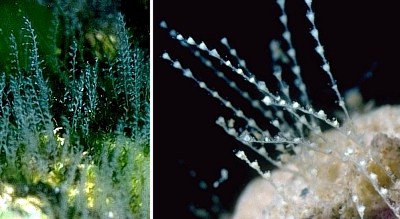
Hydroids
Phylum: CNIDARIA
Class: HYDROZOA
Order: HYDROIDA
PHOTO
UPPER RIGHT: Two common hydroids in rockpools around Sydney. Both are members of the Leptomedusae with the polyps protected by hydrothecal cups. The triangular structures in right colony are the cups protecting individual polyps. Size: Left - each erect frond aprox 10mm. Right - each branch approx 5mm. See further photos below.
These plant-like organisms (ORDER HYDROIDA) are animals. They are related to jellyfish, sea anemones and corals (PHYLUM CNIDARIA). Many have an complicated lifecycle with a fixed plant-like asexual generation and a free-swimming jelly-fish like sexual generation (medusa). We are most familiar with the fixed plant-like generation. The most simple examples of that are the solitary freshwater species of Hydra which completely lack a skeleton. Marine hydroids usually exist as colonies, the polyps are protected by a horny perisarc which. The colony can either be a branching sessile structure attached to the substrate or it can have erect fern-like 'fronds' with microscopic polyps arranged along the individual branches. There are two major suborders of hydroids.
S.O. Anthomedusae.
The polyp is not protected by the exoskeleton which stops at the base of the polyp. (Also known as 'gymnoblastic hydroids' or Athecata)
S.O. Leptomedusae.
Both the polyp and specialised gonad structures are protected by exoskeleton cups. (Also known as 'Calyptoblastic hydroids', Thecata).
All hydroids are carnivorous animals, catching prey in the water column with the aid of stinging and grappling nematocysts. Aeolids and some dendronotaceans, such as Doto, prey on most families of hydroids, and in most cases each nudibranch species specialises on one or a few species of hydroid.
PHOTOS:
These photos are of hydroids of the suborder Anthomedusae, which have unprotected polyps.
Lower Left: Two polyps of a branched colony to show structure of polyp. Note long sticky tentacles aranged in a circle around the mouth (manubrium) and body. The ball shaped structures attached to the manubrium are developing 'gonads' where medusae develop and bud off. Size: tentacle length 1mm. Lower Right: Ralpharia a large solitary hydroid preyed upon by Pteraeolidia. Size: Tentacle length approx 12mm. Photos: Bill Rudman.
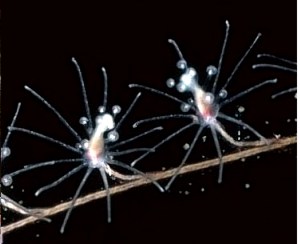
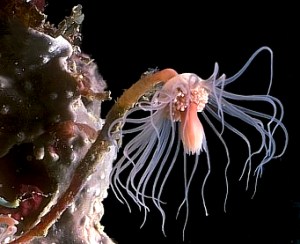
Rudman, W.B., 2000 (April 29) Hydroids. [In] Sea Slug Forum. Australian Museum, Sydney. Available from http://www.seaslugforum.net/find/hydroids
Related messages
Marine plants?
April 30, 2000
From: Valda Fraser
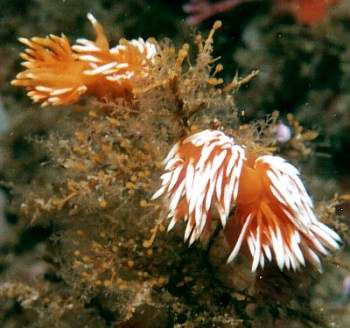
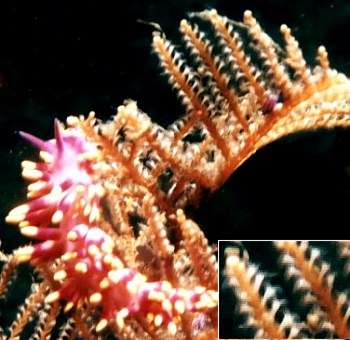
Dear Bill
I would like to know more about what nudibranchs eat and so I need to learn to identify different food sources. Do you know of useful publications?
I have included photos of two different plants which are important in the diet of certain nudibranchs which occur on the south ooast of KwaZulu-Natal. I hope you will be able to identify the plant types and be able to tell me if they occur widely or not.
Thanks,
Valda Fraser
iti04937@mweb.co.za
Fraser, V., 2000 (Apr 30) Marine plants?. [Message in] Sea Slug Forum. Australian Museum, Sydney. Available from http://www.seaslugforum.net/find/2329Dear Valda,
Good question. One way to get an idea of what things feed on is to use the SEARCH button in the blue bar at the top and bottom of each page. Type in words such as food or feeding and see what you come up with. I am gradually adding pages which will give you a better idea of who feeds on what.
Now to your present question. They certainly look like plants but they are hydroids, which are colonies of animals (called polyps) which look just like little sea-anemones. I have prepared a Hydroid Page to give you some background information on them. They are the favourite food of many aeolids and some dendronotoideans.
In your upper photo, the orange balls are specialised sacs called gonotheca in which the jellyfish-like medusa generation of their lifecycle is produced. In the lower photo you can see the rows of polyps arranged in rows along each branch.
Best wishes,
Bill Rudman.
